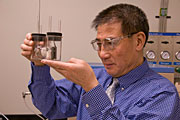Home > Press > New electrode for improved lithium-ion battery performance
 |
| Dr. Ming Au developed nanostructured anodes |
Abstract:
A new kind of anode developed at DOE's Savannah River National Laboratory is expected to increase the energy density of lithium-ion batteries four-fold—or enough to enable the battery to power an electric car for 300 miles on a single charge.
New electrode for improved lithium-ion battery performance
Aiken, SC | Posted on August 4th, 2009The energy storage capacity of today's lithium-ion batteries is limited by the widely used graphite anode, in which lithium (Li) ions are sandwiched into the carbon layer structure, with every six carbon atoms accommodating one Li atom. This structure gives the graphite anode a theoretical capacity of 372mAh/g. Reaching the 300-mile goal will require increasing the energy density 3-4 times that of the traditional anode.
SRNL's Dr. Ming Au developed nanostructured anodes that not only reach the desired increase in energy density, but use a production method that eliminates safety and environmental concerns presented by standard fabrication of carbon based anodes. The next challenge will be to sustain that energy density through multiple charge-discharge cycles.
His solution uses nanorods of various metals and metal oxides directly formed with the current collectors. Although tiny, these nanorods have the advantage of large surface areas for lithium ions to access, which means they can bind a higher number of lithium cations than the conventional graphite design.
Studies of these formations have shown that numerous inexpensive metals and metal oxides can be considered for nanorod formations to elevate charge capacities of the anodes in lithium-ion batteries. Further studies are ongoing to explore other nanostructure such as nanoporous hollow spheres of metals and metal oxides, understand the mechanism of lithium reaction in anode and sustain the high energy density through multiple charge-discharge cycles.
####
About Savannah River National Laboratory
SRNL is collaborating in several new projects to advance the nation’s energy security under two programs recently announced by the U.S. Department of Energy, the Energy Frontier Research Centers and the Nuclear Energy University Program.
For more information, please click here
Contacts:
Media Relations
Angeline (Angie) French
(803) 725-2854
Savannah River National Laboratory
Savannah River Site
Aiken, SC 29808
Copyright © Savannah River National Laboratory
If you have a comment, please Contact us.Issuers of news releases, not 7th Wave, Inc. or Nanotechnology Now, are solely responsible for the accuracy of the content.
| Related News Press |
News and information
![]() Researchers develop molecular qubits that communicate at telecom frequencies October 3rd, 2025
Researchers develop molecular qubits that communicate at telecom frequencies October 3rd, 2025
![]() Next-generation quantum communication October 3rd, 2025
Next-generation quantum communication October 3rd, 2025
![]() "Nanoreactor" cage uses visible light for catalytic and ultra-selective cross-cycloadditions October 3rd, 2025
"Nanoreactor" cage uses visible light for catalytic and ultra-selective cross-cycloadditions October 3rd, 2025
Possible Futures
![]() Spinel-type sulfide semiconductors to operate the next-generation LEDs and solar cells For solar-cell absorbers and green-LED source October 3rd, 2025
Spinel-type sulfide semiconductors to operate the next-generation LEDs and solar cells For solar-cell absorbers and green-LED source October 3rd, 2025
Announcements
![]() Rice membrane extracts lithium from brines with greater speed, less waste October 3rd, 2025
Rice membrane extracts lithium from brines with greater speed, less waste October 3rd, 2025
![]() Researchers develop molecular qubits that communicate at telecom frequencies October 3rd, 2025
Researchers develop molecular qubits that communicate at telecom frequencies October 3rd, 2025
![]() Next-generation quantum communication October 3rd, 2025
Next-generation quantum communication October 3rd, 2025
![]() "Nanoreactor" cage uses visible light for catalytic and ultra-selective cross-cycloadditions October 3rd, 2025
"Nanoreactor" cage uses visible light for catalytic and ultra-selective cross-cycloadditions October 3rd, 2025
Environment
![]() Researchers unveil a groundbreaking clay-based solution to capture carbon dioxide and combat climate change June 6th, 2025
Researchers unveil a groundbreaking clay-based solution to capture carbon dioxide and combat climate change June 6th, 2025
![]() Onion-like nanoparticles found in aircraft exhaust May 14th, 2025
Onion-like nanoparticles found in aircraft exhaust May 14th, 2025
![]() SMART researchers pioneer first-of-its-kind nanosensor for real-time iron detection in plants February 28th, 2025
SMART researchers pioneer first-of-its-kind nanosensor for real-time iron detection in plants February 28th, 2025
Energy
![]() Sensors innovations for smart lithium-based batteries: advancements, opportunities, and potential challenges August 8th, 2025
Sensors innovations for smart lithium-based batteries: advancements, opportunities, and potential challenges August 8th, 2025
![]() Simple algorithm paired with standard imaging tool could predict failure in lithium metal batteries August 8th, 2025
Simple algorithm paired with standard imaging tool could predict failure in lithium metal batteries August 8th, 2025
Automotive/Transportation
![]() Sensors innovations for smart lithium-based batteries: advancements, opportunities, and potential challenges August 8th, 2025
Sensors innovations for smart lithium-based batteries: advancements, opportunities, and potential challenges August 8th, 2025
![]() Simple algorithm paired with standard imaging tool could predict failure in lithium metal batteries August 8th, 2025
Simple algorithm paired with standard imaging tool could predict failure in lithium metal batteries August 8th, 2025
Battery Technology/Capacitors/Generators/Piezoelectrics/Thermoelectrics/Energy storage
![]() Rice membrane extracts lithium from brines with greater speed, less waste October 3rd, 2025
Rice membrane extracts lithium from brines with greater speed, less waste October 3rd, 2025
![]() Sensors innovations for smart lithium-based batteries: advancements, opportunities, and potential challenges August 8th, 2025
Sensors innovations for smart lithium-based batteries: advancements, opportunities, and potential challenges August 8th, 2025
![]() Deciphering local microstrain-induced optimization of asymmetric Fe single atomic sites for efficient oxygen reduction August 8th, 2025
Deciphering local microstrain-induced optimization of asymmetric Fe single atomic sites for efficient oxygen reduction August 8th, 2025
|
|
||
|
|
||
| The latest news from around the world, FREE | ||
|
|
||
|
|
||
| Premium Products | ||
|
|
||
|
Only the news you want to read!
Learn More |
||
|
|
||
|
Full-service, expert consulting
Learn More |
||
|
|
||








